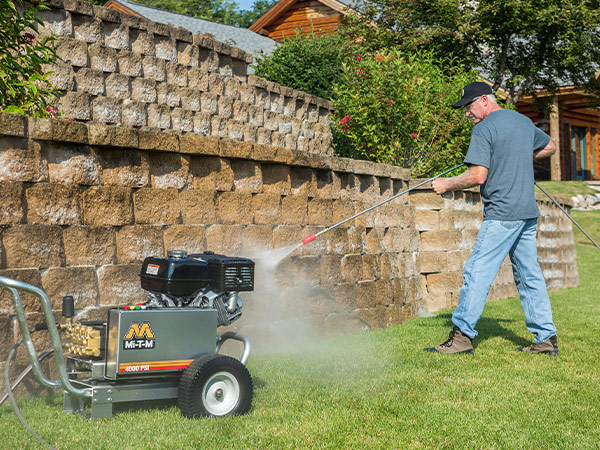
Pressure washing is one of the most satisfying home maintenance tasks — watching years of grime blast away in seconds is pure magic. ✨ But with all that power comes a common (and frustrating) problem: overspray.
Whether it’s dirty water hitting your windows, spray mist landing on your car, or chemicals splashing into your flower beds 🌸🚗, overspray can create more cleanup than the original job.
So, how do you prevent pressure washing overspray while still getting a deep, satisfying clean? 💦 Let’s break it down.
🎯 What Is Overspray?
Overspray is any unintended spray or splash from a pressure washer that lands on:
- Nearby surfaces (windows, siding, vehicles)
- Landscaping or lawns
- You (soaked clothes, anyone? 😅)
- Other people or pets in the area
It happens when water ricochets off the cleaning surface or spreads beyond your target zone. It’s especially common on windy days or when using high-pressure nozzles too close to edges or corners.
🚫 Why Overspray Matters
- Damage Risk: Overspray can strip paint, dent soft wood, or seep into unwanted places
- Mess: It splashes dirt and grime back onto areas you already cleaned
- Waste: You use more water and detergent than needed
- Safety: Wet surfaces can become slippery or create electrical hazards
Avoiding overspray is key to a cleaner, safer, and more efficient job. Let’s go over how to do that. ✅
🧰 1. Use the Right Nozzle
Not all nozzles are created equal. A 0° red tip creates a focused blast — great for removing gum, terrible for overspray control. For most general cleaning:
- Use a 25° (green) or 40° (white) nozzle for wide, even coverage
- A soap nozzle (65°) helps spread detergent gently without splash-back
These fan-shaped patterns reduce ricochet and let you control your cleaning path better. 🎯
Browse Amazon Here For Popular Pressure Washers And Accessories
🧼 2. Spray at the Correct Angle
Overspray happens most when people spray directly at a surface — especially flat, horizontal ones like decks or driveways.
Instead:
- Spray at a 45-degree angle
- Keep the tip moving in a consistent motion
- Avoid spraying directly at corners, edges, or joints
This lets water flow downward and away rather than bouncing back at you or your surroundings.
🌬️ 3. Check the Wind Conditions
Even a light breeze can turn a fine mist into a backyard water show. 😵💫
Before you start:
- Avoid pressure washing on windy days
- Work with the wind at your back, not against it
- Use temporary plastic sheets to block wind if needed
This keeps you dry and your detergent where it belongs.
🪟 4. Protect Surrounding Areas
Anything nearby that you don’t want wet or dirty? Cover it.
- Use drop cloths, plastic tarps, or painter’s tape to shield windows, doors, and plants
- Cover electrical outlets or lighting fixtures with plastic bags and duct tape
- Move vehicles or patio furniture out of splash range
Think of it as a rain-free zone for anything valuable. ☔
👣 5. Maintain the Right Distance
Keep your pressure washer wand 12–18 inches away from the surface. Too close = more pressure = more splash.
The sweet spot balances power and control — you’ll blast dirt without water flying in all directions.
🧪 6. Use Eco-Friendly Detergents
If your overspray does get on plants or porous surfaces, a biodegradable cleaner will reduce harm. Look for labels marked:
- “Pet safe”
- “Plant-friendly”
- “Non-toxic”
This is especially important when cleaning near gardens, patios, or children’s play areas. 🌱👶
Browse Amazon Here For Eco-Friendly Pressure Washing Detergents
📐 7. Use a Surface Cleaner for Flat Areas
Trying to clean a driveway, sidewalk, or patio? Instead of using a standard nozzle, invest in a surface cleaner attachment. These round, rotating tools keep water contained under a plastic housing — virtually eliminating overspray.
Bonus: they clean faster and more evenly, too! 🚀
🧼 8. Work Methodically
- Clean from top to bottom so dirt and water run downward
- Rinse as you go so detergent doesn’t dry and re-spray
- Pause between sections to assess for splash zones
A steady pace reduces errors — and overspray.
✅ Final Thoughts
Pressure washing is powerful, but control is everything. 🎯
To prevent overspray:
- Choose the right nozzle
- Use proper angles and distance
- Work with the wind and shield surrounding areas
- Invest in attachments like surface cleaners when needed
Take the time to prep and plan, and you’ll spend more time admiring your clean surfaces — and less time rinsing off splashed-up dirt. 🧼💪🏠
Browse Amazon Here For Popular Pressure Washers And Accessories






